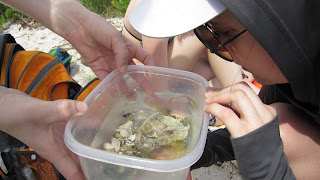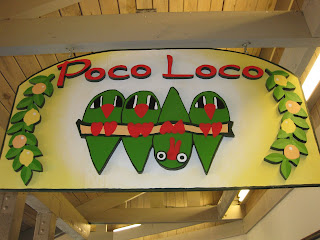Day One-
Today started out early, 3:30 am to be exact. After pulling myself out of bed, getting ready for the day and packing up a few last minute things I picked up Sam and we were on our way to the Detroit airport. To my surprise, we were able to drive, park, and get through security all within 40 minutes. After arriving at the gate two hours early we sat down and enjoyed our extremely high calorie muffin breakfast while we waited for the others to arrive.
The others trickled in and before we knew it we were boarding the plane. The flight was very uneventful- probably because I slept the whole time. After what seemed like no time at all we were at Fort Myers. It was then off to the baggage claim, to the car rental desk, to subway and finally to Sanibel Island where our lodging was for the next few days. As we arrived to the hotel I think we were all over joyed to finally see the sun and feel its warmth after a long Michigan winter. While Cara was checking us into our rooms we waited outside only to find our first friend- Liam the lizard.

After we were checked in we were told we didn't have anything on the agenda for two hours. Naturally we all put on our swimsuits and walked all but three steps to get to the beach. Some started collecting shells right of the bat, while others splashed around in the refreshing Gulf waters re-energizing after a long week of final exams. Many things were found on the beach during this time- arthropods and bivalves galore as well as remains from a horseshoe and fiddler crab.
Before we knew it our two hours of beach freedom had passed before our eyes. It was now off to the Bailey-Matthews Shell Museum! Dick Weiss, a volunteer guide, met us at the entrance with a warm welcome and a smile. We then went inside the museum and watched an educational video on Sanibel Island's shells- arthropods and bivalves. My favorite part of this video was learning about olive mollusks, a large sea snail that is able to burrow below the sand in a swift manner. We learned that the olive mollusk is a carnivore that consumes bivalves and crustaceans with its foot.
After the video came to an end, Mr. Weiss lead us to a room with a variety of different shells. There he explained laterality, or handedness of shells. We talked about the lightning whelk, a sea snail, and how their openings are always the same direction- left. This tells us that those animals are left handed, likewise the ones with openings on the right side are right handed shells. Mr. Weiss also showed us what a Florida horse conch shell looks like. We learned that the Florida horse conch is actually not a conch at all. Although it is one of the largest univalves. I was also impressed by the color of the mantel of the Florida horse conch- bright orange!
After this we were then lead to tank with live gastropods and bivalves. We were shown many really cool things, my favorite being the albino Fighting Florida conch.
Above is a traditional Florida fighting conch (left) next to an albino Florida fighting conch (right).
The coolest thing about the Florida fighting conch is that they're vegetarians and when they're out of the water they use their mantel to flip into the air and (hopefully) back in the water.
We later were shown the Austrailian trumpet shell. It's size alone was extremely impressive. We learned that Austrailian trumpet shells are the large mollusk (and relatively heavy).
After we left the museum we headed to the grocery store for the most important task of the day- to get ice cream. While walking to the grocery store we were distracted by the poco loco, a local ice cream shop. We indulged in very expensive, but very very delicious homemade ice cream.
Back to the hotel we went. We had about 45 minutes until dinner was ready so naturally it was back to the beach! After splashing around and attempting to not be the palest group of people in Florida, dinner was ready! Ayla, Pete, Maria and Emily outdid themselves making rice and all the fixings for tacos and salad. After we scarfed down a delicious meal Rachel and Pete taught us about Sanibel Island where we learned that the island was not a nice place to live in the early 1900's for it was infested with mosquitoes. It was even to the point where you couldn't see the sky when it was daylight - gross!
For the rest of the night we were out on the beach looking for different things. I found an olive mollusk which was especially exciting as we had just learned about them earlier in the day! I also found three Florida fighting conch shells.
From there we all went our separate ways as the night wound down. I'm definitely looking forward to day two- kayaking and combing the beach!
















































